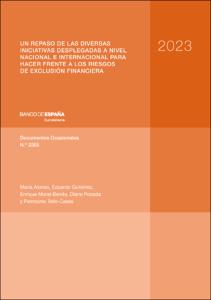Un repaso de las diversas iniciativas desplegadas a nivel nacional e internacional para hacer frente a los riesgos de exclusión financiera
Autor
Fecha de publicación
8-mar-2023
Descripción física
35 p.
Resumen
Las dificultades en el acceso a los servicios bancarios por parte de determinados grupos de
población, especialmente aquellos residentes en zonas rurales y/o de edad avanzada, suponen
una fuente de vulnerabilidad ante el riesgo de exclusión financiera de dichos colectivos. Este
trabajo ofrece un resumen de las actuaciones desplegadas al objeto de mitigar dichos riesgos en
los diferentes países europeos, con especial énfasis en el caso español. Si bien estas iniciativas
son de naturaleza diversa y dependen de factores idiosincráticos de cada país, una revisión
sistemática de las mismas permite extraer las siguientes conclusiones principales desde una
perspectiva comparada. Desde el ámbito de la iniciativa privada, cabe destacar el despliegue
en varios países europeos de redes de puntos de acceso al efectivo compartidas por diferentes
entidades bancarias, si bien su implantación es, por el momento, relativamente menor en el
caso español. Respecto a las iniciativas de colaboración público-privada, tanto en España
como en el resto de países europeos, destaca la utilización de los acuerdos entre las entidades
bancarias y las empresas de correos, que cuentan con una gran capilaridad en su red de
oficinas. Desde el ámbito público, las actuaciones más comúnmente utilizadas se refieren a
ayudas para instalar cajeros automáticos en zonas rurales. Por su parte, la regulación de los
niveles mínimos de provisión de puntos de acceso al efectivo mediante la acción legislativa solo
está vigente en el caso de Suecia, donde el uso de efectivo es tan minoritario que su potencial
desaparición supone una amenaza sobre la viabilidad de la infraestructura de efectivo.
Difficulties in accessing banking services by certain population groups, in particular those living in rural areas and/or the elderly, are a source of potential vulnerability with regard to the risk of financial exclusion of these cohorts. This paper summarises the actions deployed, by public and private institutions, in order to mitigate these risks in European countries, with special emphasis on Spain. Although these initiatives are diverse in nature and depend on idiosyncratic factors in each country, a systematic review allows the following conclusions to be drawn from a comparative perspective. First, it is worth noting the deployment in several European countries of networks of cash access points shared by different banks, although their implementation is, for the time being, relatively lower in Spain. Second, regarding public-private collaboration initiatives, both in Spain and in other European countries, the use of agreements between banks and post offices, which have well-distributed networks of offices, stands out. Third, the most common public sector initiatives consist of aid for the instalment of ATMs in rural areas. However, legislation regulating minimum provision of cash access points is only in force in Sweden, where the use of cash is so low that its potential disappearance poses a threat to the viability of cash infrastructure.
Difficulties in accessing banking services by certain population groups, in particular those living in rural areas and/or the elderly, are a source of potential vulnerability with regard to the risk of financial exclusion of these cohorts. This paper summarises the actions deployed, by public and private institutions, in order to mitigate these risks in European countries, with special emphasis on Spain. Although these initiatives are diverse in nature and depend on idiosyncratic factors in each country, a systematic review allows the following conclusions to be drawn from a comparative perspective. First, it is worth noting the deployment in several European countries of networks of cash access points shared by different banks, although their implementation is, for the time being, relatively lower in Spain. Second, regarding public-private collaboration initiatives, both in Spain and in other European countries, the use of agreements between banks and post offices, which have well-distributed networks of offices, stands out. Third, the most common public sector initiatives consist of aid for the instalment of ATMs in rural areas. However, legislation regulating minimum provision of cash access points is only in force in Sweden, where the use of cash is so low that its potential disappearance poses a threat to the viability of cash infrastructure.
Publicado en
Documentos Ocasionales / Banco de España, 2305
Materias
Inclusión financiera; Acceso a efectivo; Servicios bancarios; Zonas rurales; Financial inclusion; Access to cash; Financial services; Rural areas; Sistema monetario y financiero. Situación y análisis; Distribución de las rentas y riquezas de las personas; Economía del consumo y del ahorro
Aparece en las colecciones:












